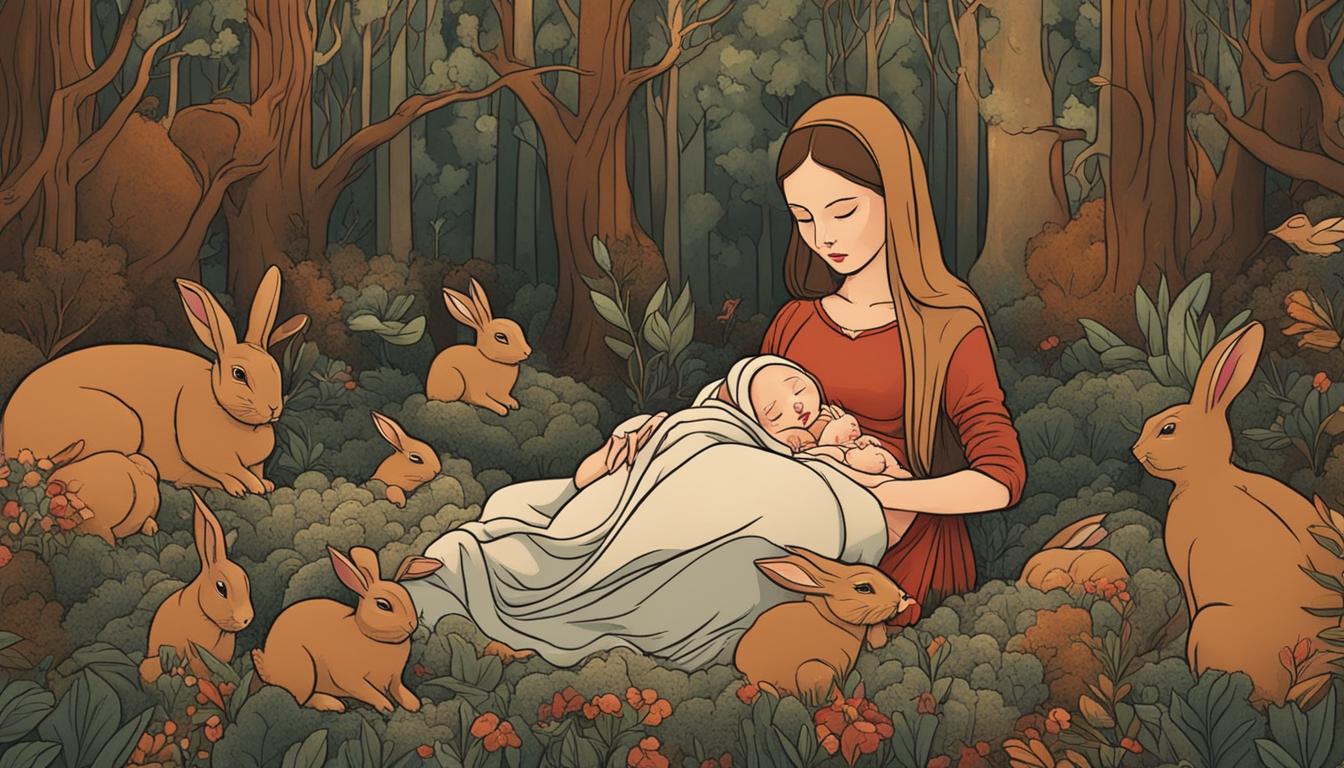“The Woman Who Gave Birth to Rabbits” is a collection of captivating historical tales written by Emma Donoghue. Each story in this collection is based on peculiar incidents in the history of the British Isles, spanning from the 1300s to the 1800s. From a 1300s Satanist to an 1800s animal-rights campaign, these stories bring to life forgotten women, queers, troublemakers, and nobodies. The book was a finalist in the 2003 Stonewall Book Award, and it has received praise for its piercing imagery, clever plotting, and vivid storytelling.
Key Takeaways:
- The Woman Who Gave Birth to Rabbits is a collection of historical tales by Emma Donoghue.
- The stories are based on peculiar incidents from the history of the British Isles.
- The book highlights forgotten women, queers, troublemakers, and nobodies.
- Emma Donoghue’s storytelling is praised for its piercing imagery and clever plotting.
- The book offers a unique glimpse into the lives of individuals who lived through extraordinary historical incidents.
The Stories in “The Woman Who Gave Birth to Rabbits”
“The Woman Who Gave Birth to Rabbits” is a captivating collection of historical tales written by Emma Donoghue. Each story in the book explores unique incidents from the history of the British Isles, offering readers a diverse range of narratives.
One of the intriguing stories in the collection is “Acts of Union,” which is set in Mayo in the early 1800s. It revolves around a fraudulent marriage and unveils the consequences of deceit and betrayal. Another fascinating tale is “Account,” an experimental story presented in a list format. It delves into the mystery surrounding a death in 1490s Scotland and keeps readers engaged with its unconventional narrative structure.
“Ballad” is another notable story inspired by the folk song of Bessy Bell and Mary Gray. It transports readers to Methven, Scotland in 1645 and explores themes of war, plague, and a love triangle. The book also includes stories that take place in different historical contexts, such as surgery in 1860s London, the Peasants Revolt in the 1380s, and the attempt to fast for forty days in 1786 Scotland.
This collection of stories in “The Woman Who Gave Birth to Rabbits” offers readers a rich tapestry of historical events and intriguing characters. Emma Donoghue’s storytelling skills bring these tales to life with vivid imagery and captivating narratives, making it a must-read for fans of historical fiction.
| Stories | Setting | Themes |
|---|---|---|
| “Acts of Union” | Mayo in the early 1800s | Fraudulent marriage, deceit, betrayal |
| “Account” | 1490s Scotland | Mystery, death, unconventional narrative |
| “Ballad” | Methven, Scotland in 1645 | War, plague, love triangle |
| Other Stories | Various historical contexts | Diverse themes ranging from surgery to social uprisings |
Unique Historical Incidents Explored in the Stories
The stories in “The Woman Who Gave Birth to Rabbits” delve into unique and extraordinary historical incidents that captivate and intrigue readers. Emma Donoghue draws inspiration from obscure moments in history to create a collection of gripping tales that shed light on forgotten individuals and events.
“The Last Rabbit”
One of the standout stories in the collection is “The Last Rabbit,” which centers around the infamous Mary Toft. In the 1720s, Mary Toft claimed to have given birth to a litter of rabbits, leading to widespread astonishment and disbelief throughout England. Donoghue weaves a fascinating narrative around this bizarre incident, exploring the motivations behind Mary Toft’s deception and the reactions of those around her.
“Cured”
Another remarkable story in the collection is “Cured,” which takes inspiration from the controversial surgeon Isaac Baker Brown’s case notes from 1860s London. Brown, known for his unorthodox surgical practices, became a subject of intense scrutiny and controversy during his time. Donoghue skillfully creates a vivid portrayal of Brown’s patients and the ethical dilemmas surrounding his methods.
Each story in “The Woman Who Gave Birth to Rabbits” offers a unique glimpse into the lives of individuals who lived through these extraordinary historical incidents, presenting a mesmerizing blend of fact and fiction. Donoghue’s meticulous research and engaging storytelling bring these forgotten moments in history to life in a truly captivating way.
Highlights and Themes of “The Woman Who Gave Birth to Rabbits”
“The Woman Who Gave Birth to Rabbits” is a collection of captivating historical tales that delves into a wide range of themes and highlights the resilience and struggles of women throughout history. Emma Donoghue’s storytelling skillfully brings these themes to life, intertwining them with vivid imagery and clever plotting.
Highlights of “The Woman Who Gave Birth to Rabbits”
- Fraudulent marriages: The book explores the theme of fraudulent marriages through stories like “Acts of Union,” set in Mayo in the early 1800s, which follows a fraudulent marriage and its consequences.
- Role of women in society: “The Woman Who Gave Birth to Rabbits” examines the limitations and complexities of women’s roles in society during different time periods, shedding light on their resilience and agency.
- Treatment of minorities: The collection touches upon the treatment of minorities, highlighting the challenges and discrimination faced by marginalized individuals throughout history.
- Limitations imposed on women: By exploring historical incidents, the book reflects on the limitations imposed on women, shedding light on the societal restrictions they had to navigate.
These highlights showcase the depth and richness of the themes explored in “The Woman Who Gave Birth to Rabbits.” Through her storytelling, Emma Donoghue presents a thought-provoking examination of historical events and the experiences of women.
The stunning imagery and intricate plotting employed by Donoghue create a reading experience that is both compelling and enlightening. Each story within the collection provides readers with a fresh perspective on history, underscoring the resilience and strength of the women who shaped it.
Critical Acclaim and Reviews for “The Woman Who Gave Birth to Rabbits”
“The Woman Who Gave Birth to Rabbits” has received critical acclaim for its unique approach to historical fiction and its powerful storytelling. Elle magazine praised the book for its “earthy, exhilarating tales,” while Time Out described it as having “piercing imagery, clever plotting, and splendid stories.” The Washington Post commended Emma Donoghue for her ability to bring history to life and described the collection as an “inspired dance on the narrow and exhilarating cliff-edge of art.” The book has been lauded for its richly textured details and its exploration of gender issues throughout history.

| Publication | Review Quote |
|---|---|
| Elle Magazine | “Earthy, exhilarating tales that transport readers through time.” |
| Time Out | “Piercing imagery, clever plotting, and splendid stories make this collection a must-read for historical fiction enthusiasts.” |
| The Washington Post | “An inspired dance on the narrow and exhilarating cliff-edge of art, bringing history to life with grace and accuracy.” |
Legacy and Influence of “The Woman Who Gave Birth to Rabbits”
“The Woman Who Gave Birth to Rabbits” has had a lasting impact on the genre of historical fiction. The book’s unique approach to storytelling, combining scholarly research and imaginative storytelling, has influenced other authors in their exploration of forgotten historical figures and events. Emma Donoghue’s blending of fact and fiction has inspired other writers to delve into the lives of marginalized individuals throughout history, bringing their stories to a wider audience.
Emma Donoghue and Her Other Noteworthy Works
Emma Donoghue is a highly acclaimed author known for her diverse body of work. In addition to “The Woman Who Gave Birth to Rabbits,” she has written other notable novels and collections of short stories. Some of her other works include:
- Room: Shortlisted for the Man Booker Prize and adapted into a critically acclaimed film
- Frog Music: A gripping historical crime novel
Donoghue’s skillful storytelling and ability to create compelling and complex characters have garnered praise from readers and critics alike.
| Book | Awards |
|---|---|
| The Woman Who Gave Birth to Rabbits | Finalist in the 2003 Stonewall Book Award |
| Room | Shortlisted for the Man Booker Prize |
| Frog Music | Nominated for the Irish Book Awards |
Where to Purchase “The Woman Who Gave Birth to Rabbits”
“The Woman Who Gave Birth to Rabbits” is available for purchase in both paperback and ebook formats. In the US, readers can find the book on the HMH website, while in the UK, Ireland, and Australia, the book is available through the Little, Brown Book Group. Links to purchase the book in various formats are provided in the sources mentioned at the beginning of this article.
If you’re eager to dive into the captivating stories in “The Woman Who Gave Birth to Rabbits,” there are multiple options for purchasing this book. Depending on your location and preference, you can choose between the convenience of an ebook or the tangible experience of a paperback.
For readers in the United States, the HMH website offers an easy way to purchase the book in both digital and physical formats. Simply visit their website and follow the provided links to complete your purchase.
If you’re located in the UK, Ireland, or Australia, the Little, Brown Book Group is the authorized distributor of “The Woman Who Gave Birth to Rabbits.” They provide options to purchase the book in various formats, catering to different reading preferences.
By clicking on the links provided in the sources mentioned at the beginning of this article, you can directly access the respective websites and explore the available options for purchasing “The Woman Who Gave Birth to Rabbits.” Enjoy immersing yourself in Emma Donoghue’s captivating historical tales!
Scholarly Discussions and Analysis of “The Woman Who Gave Birth to Rabbits”
“The Woman Who Gave Birth to Rabbits” has been the subject of scholarly discussions and analysis. Researchers and academics have written papers and thesis chapters exploring the themes, techniques, and impact of the book. Topics covered include the portrayal of queer life and women’s activism, the use of metafiction, and the biocapitalization of the female body in the stories. These discussions and analyses provide further insights into the depth and significance of Emma Donoghue’s work.
Conclusion
“The Woman Who Gave Birth to Rabbits” is a captivating collection of historical tales that brings to life forgotten individuals and incidents from the past. Emma Donoghue’s skillful storytelling and meticulous research create a vivid and immersive reading experience. Through her stories, she explores themes of gender, power, and resilience, shedding light on the struggles and triumphs of women throughout history. Whether you are a fan of historical fiction or simply enjoy engaging storytelling, “The Woman Who Gave Birth to Rabbits” is a book that is sure to leave a lasting impression.



